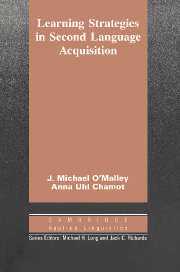Book contents
- Frontmatter
- Contents
- Series editors' preface
- Preface
- 1 Introduction
- 2 A cognitive theory of learning
- 3 How cognitive theory applies to second language acquisition
- 4 Learning strategies: methods and research
- 5 Strategies used by second language learners
- 6 Instruction in learning strategies
- 7 Learning strategies: models and materials
- 8 Summary and conclusions
- Glossary
- References
- Author index
- Subject index
3 - How cognitive theory applies to second language acquisition
Published online by Cambridge University Press: 05 October 2012
- Frontmatter
- Contents
- Series editors' preface
- Preface
- 1 Introduction
- 2 A cognitive theory of learning
- 3 How cognitive theory applies to second language acquisition
- 4 Learning strategies: methods and research
- 5 Strategies used by second language learners
- 6 Instruction in learning strategies
- 7 Learning strategies: models and materials
- 8 Summary and conclusions
- Glossary
- References
- Author index
- Subject index
Summary
In the previous chapter we argued that second language acquisition cannot be understood adequately without reference to the interaction between language and cognition. We indicated that language and cognition interact through the way that concepts are stored in memory, both in declarative and in procedural knowledge, and discussed the influence of stored knowledge on the comprehension of language where new concepts or ideas are presented. Perhaps most significantly, cognitive theory was shown to provide explanatory concepts for language acquisition as well as for language comprehension and production. One other important part of the foundation for describing second language acquisition is that strategies for learning can also be described within the framework provided by cognitive theory. As will be seen, this is an essential step in being able to describe further the process of second language acquisition.
In this chapter we apply cognitive theory to a set of prevalent constructs that have emerged in the second language acquisition literature. We confront the notion that second language acquisition must be explained by reference to a special set of principles or constructs that depend on the notion that language is a unique phenomenon operating outside the usual range of explanations offered for other types of behavior. These constructs include common underlying proficiency, transfer, metalinguistic awareness, interlanguage, automatic processing, communicative competence, and the distinction between acquisition and learning. For each construct, we define the term, explain why it is important in second language acquisition, and then provide a theoretical examination of the construct based on cognitive theory.
Information
- Type
- Chapter
- Information
- Learning Strategies in Second Language Acquisition , pp. 56 - 84Publisher: Cambridge University PressPrint publication year: 1990
Accessibility standard: Unknown
Why this information is here
This section outlines the accessibility features of this content - including support for screen readers, full keyboard navigation and high-contrast display options. This may not be relevant for you.Accessibility Information
- 1
- Cited by
